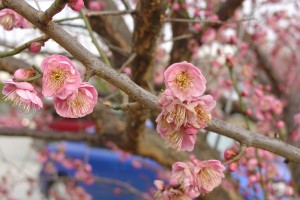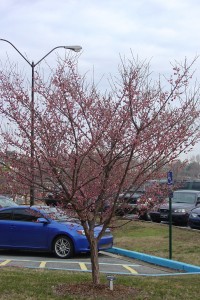Flowering apricot (Prunus mume) is native to southeastern Asia(USDA hardiness zones 6-8). It is primarily grown for its mid to late winter bloom of pink flowers.
This small 15-20 feet tall tree grows in average well-drained, acidic soils in full sun to partial shade. Avoid planting in heavy or wet soils. Most abundant flowering occurs in full sun. In the deep South leaves may scorch in full day sun. Prune, if needed, immediately after flowering.
A young tree tends to be branched upright. Spicily scented pink flowers bloom anytime – during a warm winter respite or in early spring. Flowers display red calyxes and yellow stamens. Flowers are followed by small 1-inch diameter, fuzzy-skinned, green to yellow apricot fruits. The ripe clingstone fruits are harvested in mid-summer and made into jams and preserves.
Occasionally, cold winter and spring temps damage flowers and subsequent fruits. Bloom buds have a staggered dormancy so that only the open flowers and swollen buds are damaged. This ensures a long period of flowering. If left unpicked, fruits may cause a mess on lawns and sidewalks. Birds help in the cleanup. Potential insect pests include aphids, scale and borers. Bacterial canker and brown rot on fruits are probable disease problems.
Flower buds are set in fall; fall-winter pruning removes some flower buds. Flowering apricot should be prune within 4-6 weeks after flowering. Annual pruning encourages new vigorous shoots that eventually bear the future flower buds. Flowering apricots are short-lived, around 15-20 years in the U.S.
Numerous cultivars are available from on-line nurseries. ‘Peggy Clarke’ struts rose-pink double flowers; ‘Rosemary Clarke’, early white petalled double-flowered form; ‘W.B. Clarke’ has double pink flowers, and graceful weeping form.



 Posted in
Posted in 
